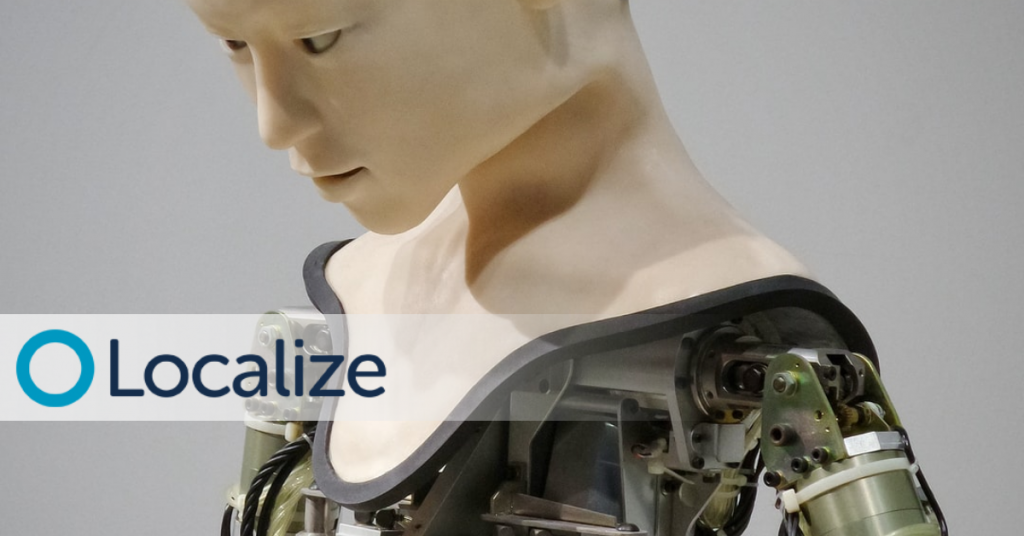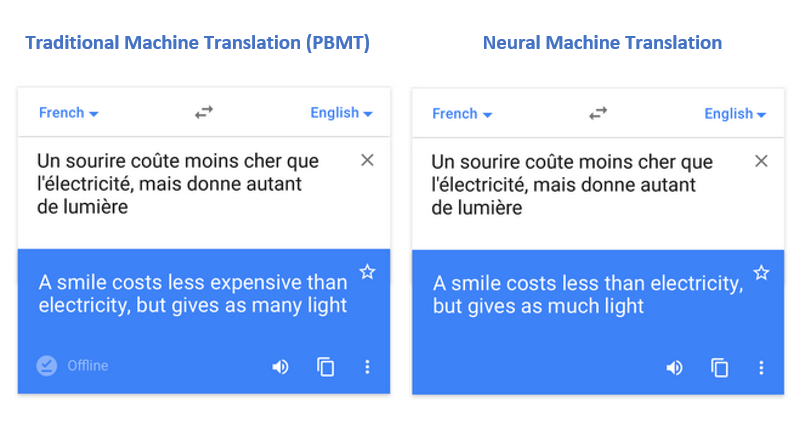Did you know that computers can be trained to understand and predict patterns? This is especially true for patterns in words and language.
Computers are now smart enough to translate an entire novel in less than two minutes. With machine learning (a form of artificial intelligence), programmers use statistical techniques to give computers the ability to learn different languages. The biggest trend in this linguistic tech is neural machine translation (NMT). NMT has the potential to revolutionize the localization industry.
What is Neural Machine Translation (NMT)?
NMT is a developing AI technology that uses deep learning to translate sentences from one language to another. Like the human brain, NMT gets smarter over time by building connections. For example, NMT can be trained to understand that the word “car” is related to “auto,” “automobile,” “vehicle,” and “cars.” Older methods of machine translation can’t build connections like this.
Before NMT came along, machine translation engines used a word-for-word approach to translation. These translations often felt stilted and robotic. NMT is smart and accurate enough to generate high-quality translations that feel more human and realistic.
This translation technology is constantly evolving, so you might be wondering if NMT will replace human translators anytime soon. Let’s explore NMT and find out.
How Neural Machine Translation (NMT) Works
Think about how humans comprehend language. When we want to translate ‘The girl rides the bike,’ our brain first makes a mental representation of what that looks like as a whole. Once we have a full mental picture, we can proceed to translate. Neural MT works similarly.
Neural machine translation translates entire sentences at a time, rather than word-by-word or phrase-by-phrase like older machine translation models. NMT uses the context of a sentence to come up with the most relevant translation. It then makes adjustments and rearrangements until the translation reads more like human speech with correct grammar.
Classic examples of publicly accessible NMT software are Google Translate and Baidu Translate. Many multinational corporations are utilizing NMT to help them overcome translation challenges related to their global expansion efforts.
Google Translate is the most widely used machine translation tool around the globe—translating over 140 billion words per day. The Google Neural Machine Translation System (GNMTS) significantly increases translation accuracy and fluency. The tech giant uses enormous data sets to train its translation algorithms and has an end-to-end design to boost learning over time.
The Architecture of Neural Machine Translation (NMT)
An NMT computer uses deep learning to build an artificial neural network to teach it how to translate between languages. This computational system strives to mimic the billions of neuron cells in the human brain that use observable data to learn and make decisions. These neural networks translate entire sentences without breaking them down into smaller parts. Neural machine translation can also predict the likelihood of a sequence of words.
To do this, NMT uses an encoder-attention-decoder model. An encoding neural network is capable of reading and encoding a source sentence into a ‘meaning vector’ or ‘thought vector.’ This vector is a number sequence that represents the meaning of the sentence. A decoder then produces a translation from the encoded vector.

The encoder-decoder system is trained with large amounts of data to maximize the probability of producing a correct translation from a source sentence. This enables it to capture dependencies in languages, such as syntax structures and gender agreement, resulting in much more fluent translations.
Neural machine translation is a single, well-trained system that can accurately translate source text to a target language. It does away with the need to use specialized systems that are typical of statistical machine learning. Its biggest strength is its ability to perform end-to-end direct learning.
NMT applies to pretty much any language, including ones that are comprehended by relatively few people. Users can fine-tune translations to suit specific types and styles of languages, e.g., UK-English, US-English, and medical, financial, and scientific language. Several industries requiring custom-developed and high-accuracy machine translation use a blend of statistical and neural translation methods.
The Pros and Cons of Neural Machine Translation (NMT)
NMT is a promising technology, but it’s far from perfect. Here are some big advantages and disadvantages of neural machine translation.
Advantages of NMT
-
- Natural-sounding language
NMT can make AI-translated language sound more human and less robotic. Here’s a great example from Google:
- Context
NMT isn’t perfect, but it does a good job of interpreting translation context. Google made recent strides in training its NMT to pay greater attention to the context of a sentence within a body of work. - Generalization
NMT gets smarter over time. Like the human brain, it can generalize to make new conclusions and connections. It uses these connections to quickly learn different language pairs. - Good accuracy in some contexts
NMT is especially good at translating repetitive content that requires high accuracy like manuals, guides, or reference materials. - Speed
Once an NMT system is trained, the translation speed is impressive. NMT can translate Charles Dickens’ A Tale of Two Cities in a little over a minute. - Flexibility and integrations
Another big advantage: NMT can be easily integrated into software with APIs and SDKs.
- Natural-sounding language
Disadvantages of NMT
-
- Need for clarity in the source text
Source text needs to be very clear for NMT to generate a quality translation. Neural machine translation has difficulties with ambiguities, highly technical language, proper nouns, and rare words. - Poor translation of long sentences
NMT generally outperforms other machine translation methods, but there’s an interesting exception. NMT can’t translate long sentences very well. - Large data sets needed
For smaller projects, NMT isn’t always a good fit. NMT systems produce comparably poor results with small data sets. Without a large amount of training data, NMT isn’t going to give you accurate translations. - Expertise limitations
NMT can’t perform well without the expertise and cognitive power of human architects and engineers. Any NMT model must be trained with a large quantity of linguistic data. - Human post-editing still needed
NMT text should always be checked by a human editor. Language interpretation requires a level of critical thinking and nuance that computers haven’t achieved yet.
- Need for clarity in the source text
Is NMT the Future of Language Translation?
As the field of computational linguistics evolves, we have a lot to look forward to. NMT technology continues to get better and better. NMT’s greatest potential is being a timesaver for translation and localization teams, with the potential to reduce the time needed for post-editing by up to 25%.
AI industry pioneer Philipp Koehn agrees that NMT is incredibly exciting, but he also encourages realistic expectations:
“It is clear that Neural Machine Translation (NMT) is yet another step up and a very promising technology. At the same time, as often with new technologies, we are currently in the ‘hype’ phase and while NMT might be right for some applications today, it is important to understand the different technologies and their respective advantages and disadvantages…”
It seems that NMT still has a long way to go before it surpasses the translation performance of people. At least for now, the human brain can’t be beaten!
Neural Machine Translation and Localization
As more companies go global, localization teams work to meet the demand for localized content in international markets. NMT reduces translation costs and helps translators produce content more quickly. However, until AI translations can 100% imitate the human brain, post-editing from human translators will always be needed.
Why Use Localize?
Localize is a translation management system that is always keeping an eye on future technical developments that can improve the quality of translations. Localize provides several cutting-edge machine translation options including Google Translate, Amazon Translate, and Microsoft Translate. Contact us to learn how we can help you combine human and machine translation to get fantastic results!








